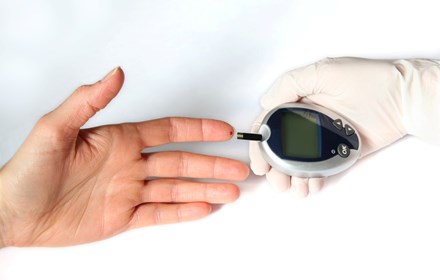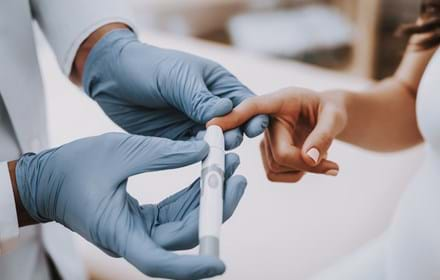
DRWF – a quarter of a century of diabetes research
In 2023, we will be celebrating the 25th anniversary of DRWF, marking 25 years of supporting people living with diabetes in the UK. Thanks to our supporters, we have helped fund vital research projects at the very best research institutions in the UK and around the world.
Since our formation in 1998, diabetes research has come a long way in improving the lives of people living with diabetes. New technological advances in glucose monitoring and insulin delivery have improved the management of diabetes for millions of people. With future innovations like the closed-loop system on the horizon, and islet cell research and transplant transforming lives, the future has never been brighter.
25 years of diabetes research

Picture: Professor Paul Johnson, Professor of Paediatric Surgery and Director of the DRWF Islet Isolation Facility and the Oxford Islet Transplant Programme.
DRWF has made a significant contribution to advancing our understanding of diabetes and its complications. Over 25 years, we have funded award-winning research, as well as becoming a lead funder of islet cell research and transplant. Our islet cell funded research programme has made a life-changing difference for a small number of people living with type 1 diabetes, as well as providing hope of a future cure for the wider diabetes community.
In 2004, we made an unprecedented grant for an Islet Isolation Facility at the Nuffield Department of Surgery at the Radcliffe Hospital, Oxford. The DRWF Human Islet Isolation Facility opened in 2006 and has since played a pivotal role in islet cell research and transplant.
Islet cell transplantation involves extracting islet cells from the pancreas of a deceased donor and implanting them in the liver of someone with type 1 diabetes. First, islets are extracted from someone who has died and given consent for their organs to be used for transplantation. If this produces a suitable number of good quality islets, they can be offered to someone in need of a transplant.
Currently, islet cell transplantation is only available for people living with type 1 diabetes who have developed severe hypo unawareness. Most people with Type 1 diabetes can manage hypos because of characteristic symptoms that tell them when their blood glucose is low. These symptoms are vitally important because they prompt people to manage hypos, preventing their glucose levels dropping further.
People who have developed hypo unawareness are unable to recognise when their blood glucose is low, potentially leading to serious consequences if the hypo is not treated.
For World Diabetes Day 2022, we produced a short documentary highlighting the success stories from DRWF-funded research and support. You can watch Our Heroes Here.
Award Winning Research

Picture: Dr Shivani Misra holding her DRWF research award.
Our funded researchers have also won prestigious awards for their work. Dr Shivani Misra, the recipient of a DRWF 3-year Clinical Fellowship in 2012, won the 2017 IDF Europe Prize for young researcher for her MY DIABETES study.
The study focused on classifying types of diabetes in people with young-onset diabetes from different ethnic groups, to investigate whether ethnicity has an impact on diabetes presentation and type. One of the key findings from the study was the discovery that genetic forms of diabetes are being misdiagnosed in people from ethnic minority groups.
Maturity onset diabetes of the young (MODY) is a rare form of diabetes which runs in families and is caused by a mutation in a single gene. MODY is very rare compared with type 1 and type 2 diabetes, and around 20,000-40,000 people in the UK have it.
As part of MY DIABETES, Dr Misra outlined that healthcare professionals are missing cases of MODY in south Asian and African Caribbean individuals – who then may not receive the right treatment compared with White Europeans.
Dr Misra also found that using broader criteria, such as whether a person is making their own insulin, identified undiagnosed cases of MODY in non-white ethnic groups. Dr Misra suggested that using these new guidelines could help doctors to better diagnose MODY and refer more patients for genetic testing.
In 2018, Dr Misra was named in the Evening Standard 1000 health influencers for her work on the misdiagnosis of thousands of patients due to misconceptions about the role of ethnicity and diabetes. She also received the Outstanding Educator Award at the 2021 Quality in Care Diabetes awards for her MY DIABETES study and is currently a member of the DRWF Board of Trustees.
A recently published DRWF-funded study, led by Dr Kashyap Patel, looked at the usefulness of the islet autoantibody test in adults and young people who are suspected of having type 1 diabetes. This study resulted in the National Institute for Health and Care Excellence (NICE) changing the guidelines that suggest testing these antibodies in all clinical cases.
Autoantibodies are immune proteins that mistakenly target and react with a person’s own tissues or organs. The test is available in routine clinic practice across the UK. However, the additional benefit of measuring these antibodies when someone have strong clinical suspicion of type 1 diabetes, particularly in adult-onset, is not known. Currently, it is performed more widely when there is diagnostic uncertainty.
Dr Patel assessed the genetic risk of type 1 diabetes in a large number of autoantibody-negative and -positive children and adults.
The results of the study suggest that a lack of islet autoantibodies greatly changes the diagnosis in the adult/late-onset group who are clinically suspected type 1 diabetes. This highlighted the importance of routine testing for islet autoantibodies at diagnosis in all patients suspected to have adult/late-onset type 1 diabetes.

DRWF has also worked collaboratively with other leading UK diabetes charities and medical institutions on important research. In 2020, we part-funded a project into gestational diabetes, which revealed the top 10 unanswered questions of pregnant women living with diabetes.
Around 38,000 women with diabetes give birth in the UK each year (5% of pregnancies) and rates are rising. This can cause complications during pregnancy and birth, and may have long-term effects for mother and child, such as cardiovascular disease.
The list produced by the research study revealed the top ten research questions that women, their support networks, and healthcare professionals agree are the most important for research to address in diabetes and pregnancy. With the results publicly available, it is hoped that project will encourage the funding of research studies relating to diabetes and pregnancy and aligned with the priorities of those impacted by it.
Developing Technology
Continuous glucose monitors (CGM)
When the first blood glucose monitor was developed in 1971, it was globally hailed as a significant step in advancing the care of people living with diabetes. For the first time, meters enabled people to self-monitor their blood glucose levels at home. As the accuracy and portability of meters improved, they became the standard method of rapid blood glucose testing for both patients and healthcare professionals.
In 1999, the next step in blood glucose testing was revealed as Medtronic released the world’s first continuous glucose monitor (CGM). The Sof-sensor was a small, wearable device which continuously tracked a user’s blood glucose levels throughout an entire day. This was a significant development in diabetes technology which has since improved greatly.
Modern CGM systems are designed to be small, comfortable devices which can be scanned using a smartphone, allowing for Bluetooth pairing for glucose and signal loss alarms. In recent years, Abbott’s FreeStyle Libre, a flash glucose monitor which continuously stores glucose data, has been made available on the NHS for people living with diabetes.
In 2022 the Dexcom One became the first real time-continuous glucose monitor (rt-CGM) available in pharmacies in the UK. The monitor requires no scanning and eliminates the need for finger-pricking tests.
By 2021, CGMs have become more widely available to patients living in the UK thanks to an NHS roll-out for people living with type 1 diabetes. Figures released by NICE found that 125,000 people living with type 1 diabetes were using life-changing CGM’s to manage their condition, eliminating the need for daily finger-pricking to check glucose levels.
Insulin delivery
Injections have been the standard practice of administering insulin for over 100 years, ever since the discovery of the life-saving drug in 1921. To the present day, millions of people living with type 1 and type 2 diabetes use daily injections of insulin to control their glucose levels.
Similar to glucose monitoring systems, insulin pens now incorporate modern technology to maximise their potential. Smart insulin pens, which have an inbuilt memory function to record the timing, date and amount of insulin administered, work alongside smartphone apps to monitor when a user should inject insulin.
Whilst the quality and efficiency of hypodermic needles, injectable insulin and delivery pens have gradually improved over time, the next biggest breakthrough for insulin delivery is a move away from daily injections.
The only other alternative delivery system, insulin pumps, have rapidly advanced since their introduction in the 1980’s. Over the past two decades, alongside the creation of CGM’s, the closed-loop system (also known as the “artificial pancreas”), is now offering a new alternative for people with diabetes.
The hybrid closed loop system consists of a continuous glucose monitor (CGM) sending information to and working simultaneously with an insulin pump. After the CGM sends information on glucose levels to the insulin pump, a calculation is run to establish how much insulin needs to be delivered into the body to keep blood glucose levels within a healthy range.
The closed-loop system has been widely praised by researchers and recent draft guidelines have suggested that the new technology could benefit 105,000 people living with type 1 diabetes in the UK.
25 years of research
Over the last 25 years, we have seen the number of people living with diabetes more than double to over 5 million. Whilst there have been some major milestones in the diagnosis, treatment, and care of diabetes in this time, our work has never been more important.
For 25 years we have been supporting people living with diabetes by raising awareness, hosting educational events, and funding vital diabetes research projects.
Thanks to the generosity of our amazing supporters, we have contributed to research that not only advances our understanding of diabetes but delivers benefit in a practical sense through improved care and treatment. We exist almost entirely on voluntary income via individual donations, legacies, trusts, and grants to support these projects that move us closer to finding a cure for diabetes.
I would like to make a regular donation of
I would like to make a single donation of
There are lots of ways to raise money to support
people living with all forms of diabetes.
Bake, Swim, Cycle, Fly ... Do It For DRWF!
Fundraise with us
Recent News






